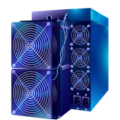MicroBT WhatsMiner M60
WhatsMiner M60 profitability insights powered by real-time data: Discover how much your WhatsMiner M60 can earn using our advanced ASIC miner calculator. We use live mining reward data and automatically factor in electricity costs, giving you a clear overview of your potential daily, monthly, and yearly returns.
Profitability Analysis
Here you can see a detailed analysis of miner profitability, updated in real-time.
| Period | Income | Expense | Profit |
|---|---|---|---|
|
Daily
|
$7.77 | $6.57 |
$1.20
|
|
Monthly
|
$233.11 | $197.11 |
$36.00
|
|
Yearly
|
$2,836.14 | $2,398.14 |
$438.00
|
About the MicroBT WhatsMiner M60 (172TH/s)
Learn more about this ASIC miner, including its specifications, performance, energy consumption, and profitability.
The MicroBT WhatsMiner M60 is a purpose-built SHA-256 ASIC for Bitcoin-class workloads, delivering 172 TH/s at 3,422 W for an efficiency of roughly 19.9 J/TH, and it marries that performance to a clear-eyed engineering package: advanced 5 nm chips, a dual-fan front-to-back air path, and reinforced hardware that sustains stable output under continuous duty. In practice, that means predictable thermal behavior, fewer throttling events, and more consistent uptime, even as ambient conditions fluctuate. With a noise level around 75 dB, it is squarely an industrial-grade unit, best placed in managed facilities with dedicated airflow and dust control. Its compact 430 x 155 x 226 mm chassis and 13.5 kg weight simplify rack planning and dense deployments, while optimized power distribution helps curb waste and keep energy use close to the theoretical envelope. For planning and operations, the numbers are concrete: a steady 3.422 kW draw equates to about 82.1 kWh per day, roughly 2,463.8 kWh per 30-day month, and about 29,976.7 kWh per year, making site readiness, heat extraction, and electrical capacity non-negotiable considerations. Profitability hinges on the familiar variables-network difficulty, pool fees, uptime, and your electricity rate-so a real-time mining calculator tied to current network data can translate hashrate and energy use into projected daily, monthly, and annual outcomes, while sensitivity checks (for example, modest swings in difficulty or fee structures) help you gauge risk. In short, the M60 is engineered for high-performance, round-the-clock mining, balancing throughput and efficiency in a form factor that rewards careful thermal design, routine maintenance of fan intakes and exhaust paths, and disciplined power provisioning.
Discover Which Coins This Miner Can Mine
Explore the cryptocurrencies that can be mined using MicroBT WhatsMiner M60 (172TH/s), including detailed profitability.
Currency Converter
Calculate the mineable coins to any currency.
| Coin | Income/Day | Profit/Day |
|---|---|---|
|
$7.28
$
0.00007152

|
$0.71
$
0.00000697

|
|
|
$7.22
$
0.00007136

|
$0.65
$
0.00000646

|
|
|
$7.09
$
0.01406329

|
$0.52
$
0.00102606

|
|
|
$7.77
$
19.38

|
$1.20
$
3.00

|
Historical Mining Performance
View the performance trends of MicroBT WhatsMiner M60 (172TH/s) over weekly, monthly, and yearly timeframes.
Historical Profitability
View the historical income and profit trends for this miner.
SHA-256 Miner Generations
Evolution of cryptocurrency mining hardware throughout the years, with the current generation highlighted for reference.
Generation 1
26 minersGeneration 2
26 minersGeneration 3
26 minersGeneration 4
26 minersGeneration 5
26 minersGeneration 6
26 minersGeneration 7
27 minersGeneration 8
27 minersGeneration 1
26 minersGeneration 2
26 minersGeneration 3
26 minersGeneration 4
26 minersGeneration 5
26 minersGeneration 6
26 minersGeneration 7
27 minersGeneration 8
27 minersMore Information about the
Learn more about the MicroBT WhatsMiner M60 (172TH/s)
Housed in an alloy shell that remembers its own heat and gives it back to the air with orderly grace, the MicroBT WhatsMiner M60 is an SHA-256 machine built for Bitcoin that pushes about 172 TH/s from advanced 5 nm silicon while drawing near 3.422 kW, yielding roughly 19.9 J/TH, and its design tends to the long march of uptime: a dual PWM fan, front-to-back path drives flow across high-efficiency heat sinks, the noise settling around 75 dB, while the upgraded power management unit apportions current like a careful steward to keep hashrate steady when line conditions ripple; dynamic frequency scaling trims or advances clocks to match the electrical and thermal moment, so throttling is measured rather than abrupt, and integrated voltage regulation shields the ASICs from stress that ages lesser boards. The firmware’s AI-based fault detection reads hashboard behavior and flags irregularities early, pairing with watchdog recovery, per-chain auto-tune, and a straightforward web console for pool setup over standard Ethernet and Stratum; operators can watch inlet and outlet temperatures, fan RPM, voltage rails, and share error rates the way a navigator keeps an eye on wind and tide, making small corrections before they become storms. Sized for density at about 430 x 155 x 226 mm and roughly 13.5 kg, the unit fits cleanly in racked rows; plan for a clean, cool intake and a clear exhaust vector, with pre-filters to tame dust without starving airflow, and schedule light vacuuming of intakes and periodic fan health checks rather than aggressive compressed air bursts that drive particulates deeper. In typical facilities, a 200–240 V AC, 50/60 Hz feed with high power factor and good grounding keeps harmonics modest and the PMU untroubled; at these voltages expect around 14–17 A per unit under steady load, so derate circuits sensibly, balance phases where applicable, and leave margin for startup and thermal excursions. Ambient best practice sits near 5–35°C with non-condensing humidity; keep an eye on altitude, since thinner air dulls cooling and the fans will chase the deficit; a small delta between inlet and outlet temperatures signals good ducting and a clean path. For industrial placements, treat the acoustic profile with ducting or muffling and consider hearing protection for nearby staff; in light commercial rooms, isolate the intake from the warm aisle to avoid recirculation and heat soak. Reliability lives in little habits: validate firmware signatures before updates, keep a spare fan and a known-good Ethernet cable on hand, log rejected shares and voltage sags, and retire dust-laden filters before they strangle the flow; should something go astray, the miner’s diagnostics and auto-recovery routines tend to land rather than crash, preserving work while you swap a fan, reseat a cable, or recalibrate a chain. In the ledger of planning, remember the constants-stable power, directed airflow, routine cleaning, and disciplined monitoring-and the M60’s balanced engineering will make the familiar hum of 24/7 hashing sound like a promise kept.
Where to Buy?
Trusted vendors and current market availability, showcasing verified suppliers offering this ASIC miner along with their latest pricing and stock information.
No Offers Available
There are currently no offers for this miner. Please check back later.
Technical Specifications
Detailed hardware specifications and mining capabilities for MicroBT WhatsMiner M60
Basic Information
Performance
Physical Dimensions
Mineable Cryptocurrencies



Algorithm Information: SHA-256
Learn more about the SHA-256 algorithm and how it works.
SHA-256 is a cryptographic hash function that serves as the backbone of Fractal Bitcoin proof-of-work consensus mechanism. This algorithm processes input data of any length and produces a fixed hash value, ensuring security and integrity in the mining process.
Crypto Mining Pools
Connect to the most reliable mining pools and maximize your crypto mining efficiency with optimized uptime and profitability.
User Reviews
See what users are saying about this miner.
No Reviews Yet
Be the first to review this miner!
Frequently Asked Questions
Everything you need to know about the MicroBT WhatsMiner M60
How efficient is the MicroBT WhatsMiner M60 172TH/s?
What are the electricity costs for the MicroBT WhatsMiner M60 172TH/s (USD)?
How much power does the MicroBT WhatsMiner M60 172TH/s use?
Who manufactures the WhatsMiner M60?
What is the hashrate of the MicroBT WhatsMiner M60?
Which cryptocurrencies can be mined with the MicroBT WhatsMiner M60 172TH/s?
 NiceHash (BTC)
NiceHash (BTC)
 Bitcoin (BTC)
Bitcoin (BTC)
 Bitcoin Cash (BCH)
Bitcoin Cash (BCH)
 Fractal Bitcoin (FB)
Fractal Bitcoin (FB)
Is the MicroBT WhatsMiner M60 172TH/s a profitable miner?
This makes the MicroBT WhatsMiner M60 172TH/s a profitable choice for mining.
 English
English
 German
German
 Hungarian
Hungarian
 Dutch
Dutch
 Spanish
Spanish
 French
French
 Italian
Italian
 Czech
Czech
 Polish
Polish
 Greek
Greek
















